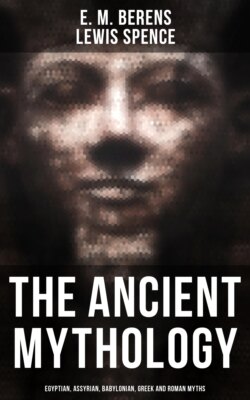Читать книгу The Ancient Mythology: Egyptian, Assyrian, Babylonian, Greek and Roman Myths - Lewis Spence - Страница 54
На сайте Литреса книга снята с продажи.
Shamash
ОглавлениеShamash, god of the sun, was one of the most popular deities of the Babylonian and Assyrian pantheon. We find him mentioned first in the reign of E-Anna-Tum, or about 4200 B.C. He is called the son of Sin, the moon-god, which perhaps has reference to the fact that the solar calendar succeeded the lunar in Babylonia as in practically all civilizations of any advancement. The inscriptions give due prominence to his status as a great lord of light, and in them he is called the 'illuminator of the regions,' 'lord of living creatures,' 'gracious one of the lands,' and so forth. He is supposed to throw open the gates of the morning and raise his head over the horizon, lighting up the heaven and earth with his beams. The knowledge of justice and injustice and the virtue of righteousness were attributed to him, and he was regarded as a judge between good and evil, for as the light of the sun penetrates everywhere, and nothing can be hidden from its beams, it is not strange that it should stand as the symbol for justice. Shamash appears at the head of the inscription which bears the laws of Khammurabi, and here he stands as the symbol for justice. The towns at which he was principally worshipped were Sippar and Larsa, where his sanctuary was known as E-Babbara, or the 'shining house.' Larsa was probably the older of the two centres, but from the times of Sargon, Sippar became the more important, and in the days of Khammurabi ranked immediately after Babylon. In fact it appears to have threatened the supremacy of the capital to some extent, and Nabonidus, the last King of Babylon, as we shall remember, offended Merodach and his priests by his too eager notice of Shamash. During the whole course of Babylonian history, however, Shamash retained his popularity, and was perhaps the only sun-god who was not absorbed by Merodach. One finds the same phenomenon in ancient Mexico, where various solar deities did not succeed in displacing or absorbing Totec, the ancient god of the sun par excellence. But Shamash succeeded in absorbing many small local sun-gods, and indeed we find his name used as that of the sun throughout Semitic lands. There were several solar deities, such as Nergal, and Ninib, whom Shamash did not absorb, probably for the reason that they typify various phases of the sun. There is reason to believe that in ancient times even Shamash was not an entirely beneficent solar deity, but, like Nergal, could figure as a warrior on occasion. But in later times he was regarded as the god who brings light and life upon all created things, and upon whom depends everything in nature from man to vegetable. His consort was Aa, who was worshipped at Sippar along with him. Her cult seems to have been one of great antiquity, but she does not appear to have any distinctive character of her own. She was supposed to receive the sun upon his setting, and from this circumstance it has been argued she perhaps represents the 'double sun,' from the magnified disk which he presents at sunset; but this explanation is perhaps rather too much on allegorical lines. Jastrow thinks that she may have been evolved from the sun-god of a city on the other side of the Euphrates from Sippar. "Such an amalgamation of two originally male deities into a combination of male and female, strange as it may seem to us," he says, "is in keeping with the lack of sharp distinction between male and female in the oldest forms of Semitic religions. In the old cuneiform writing the same sign is used to indicate 'lord' or 'lady' when attached to deities. Ishtar appears amongst the Semites both as male and female. Sex was primarily a question of strength; the stronger god was viewed as masculine, the weaker as feminine."
